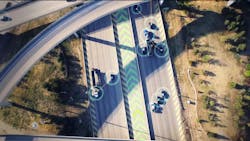Traffic can get heavy and the weather treacherous on Colorado's highly elevated Interstate 70, the primary route leading through Denver and on to popular Rocky Mountain resorts and getaways. Trying to improve flow by adding more lanes would be very difficult and very costly.
"We can't just widen the roadway by blasting away the mountain. There are environmental concerns and communities along the way," explains Shailen Bhatt, executive director of the Colorado Dept. of Transportation (CDOT). "Traditional methods would cost billions of dollars."
So instead, CDOT has partnered with HERE, a transportation IT company that's worked on projects in Finland and the Netherlands, to launch an intelligent infrastructure project on I-70 hoping to improve safety and operation of the roadway.
Setup
"It really is one of the most challenging corridors in the United States," contends Amy Ford, director of communications for CDOT. "Not only do you have vast amounts of traffic, you have really interesting travel patterns given the nature of the resorts up there and how people travel on the weekends, that kind of thing.
"Add to that very significant environmental constraints in regards to expanding the corridor, and then on top of that you have the extreme weather situations we have," she continues. "And there are no detours, no real alternate routes."
The concept of a smart road might conjure up images of cameras, roadside sensors or light strips along the shoulder that illuminate as cars travel by. The CDOT-HERE connected vehicle pilot project, however — which is part of a larger department initiative called RoadX — aims to minimize physical hardware costs and will use vehicles themselves to build, essentially, a virtual smart road using vehicle-to-vehicle (V2V) and vehicle-to-infrastructure (V2I) communication.
The first phase of the project will fit a number of passenger cars with a control box that sends info on road hazards and conditions via cellular networks. Then — and this portion is still in the works — the CDOT fleet and potentially trucking companies operating in the I-70 corridor could get involved, though they'd likely be using dedicated shortwave radios to collect and send data.
The key is that very near real-time information, maybe within about 2 seconds, can be gathered to paint the fuller picture of what's going on on I-70.
"It'll be hyper-located, hyper-specific information we're pulling off the corridor. Pull it up into the cloud, feed it with other information that we have and turn it back to the vehicles," Ford tells Fleet Owner. The project is slated for the winter of 2016-17, and "what better time to pilot than during the unpredictable winter?" the department notes in a release.
What'll it do?
What's the point of the connected vehicle tech and virtual infrastructure? Hopefully, says Ford, you'll have an interstate highway that communicates better with drivers to let them know about various, constantly updated safety issues and clears problems like traffic backups much faster.
"It can create efficiencies in travel and improve safety and mobility. We absolutely want to pursue that," she notes. "It's part of this larger concept for us with RoadX where we're looking to really deploy technology to improve and transform traffic."
The V2V/V2I project will be a probative part of that. For example, Ford explains, for every 10 minutes that an accident is in place on the I-70 corridor, it takes about an hour for traffic to clear. She recalls also a recent accident involving foggy conditions where several secondary collisions took place; trucking companies know better than anyone how costly such traffic logjams can be.
"If connected vehicle technology has the capacity to inform drivers and keep them more engaged — hey, the queue has slowed up ahead, the car ahead has slowed, slow down now — we could minimize those kinds of traffic problems," Ford says. "We think there could be tremendous benefit in the efficiency of how that corridor moves, let alone the safety impacts."
It's all about knowing what's happening with the vehicles on the road, which essentially become probes in the pilot project. Many trucking companies and fleets already are connected to their vehicles in a similar way.
The project will likely feature a voice-prompt, interactive system. Cars and trucks in the CDOT project might get warnings about things like icy conditions, an approaching heavy curve or steep grades, according to Ford, or trucks could get info about space availability in chain-up stations where drivers install chains when needed.
"There's so much that just this information could share," she says. "We think there's great potential in this."
About the Author
Aaron Marsh
Aaron Marsh is a former senior editor of FleetOwner, who wrote for the publication from 2015 to 2019.



